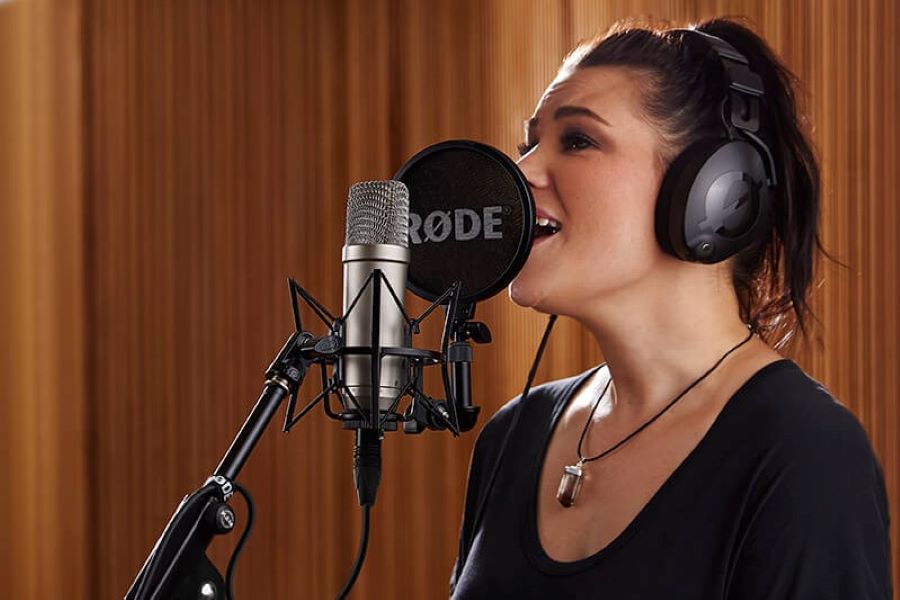The ideal option for an untreated room or space is a condenser microphone. This mic type has more sound sensitivity features than ribbon or dynamic styles, recording directly on the diaphragm.
That means a condenser microphone picks up the frequencies and vibrations of the sounds in the room instead of those passing through the air around the equipment.
It is handy for podcasting and studio recording because the audio source gets picked up from a more comprehensive frequency range. That outcome makes your voice sound natural and authentic instead of tinny and hollow.
Condenser mics come with an M/S switch, allowing you to capture stereo signals if you have two microphones to use for your podcast. The disadvantage of this setup is that an untreated room delivers more risk factors for feedback and background noise since more sounds get recorded.
Related: How to Remove Background Noise & Static in Audacity
What Are the Best Microphones to Use in an Untreated Room?

A female singer using Rode NT1-A condenser mic for recording. Image Source.
Although a condenser microphone might be better than all types, some brands provide better, more consistent results than others. If you’re thinking about starting or upgrading a podcast right now, you’ll want to give these mics a closer look.
Related: Best Microphones For Recording in Podcasting and How To Make A Microphone Sound Better
Our Top 3 Picks:

- Reduces pickup of sounds from sides and rear
- Perfect for live vocals
- Plug-and-play design
- Affordability
1. Rode NT1-A
This small condenser microphone is as helpful in the podcasting studio as it is for a live stage performance. The Rode NT1-A features a broad frequency range and low self-noise levels to deliver pure sound goodness.
The design features cardioid polar patterns, phantom power, an XLR cable, and a three-position filter switch. It’s ready for wireless recording, connecting to iOS devices through a dock connector.
You’ll find the tone is a bit brash and in-your-face, but it isn’t harsh. It’s resistant to handling noise, even when held, and comes with a dust cover and a pop shield to eliminate vocal distortion.
Related: Top 8 Best Mic for Noisy Environment
2. Audio-Technica AT2020
This analog XLR microphone can help you start a podcast in minutes. The Audio-Technica AT2020 uses a plug-and-play design that works with virtually any computer.
You also have access to a USB output with this design for digital recording and editing.
Audio-Technica optimized this condenser microphone for live vocals. It could benefit from a more rugged exterior, but the electronics do an excellent job of eliminating ambient noise from the nearby environment.
You can record your podcast in peace, even if you don’t live in the quietest environment, with the headphone jack and volume controls that allow for no-delay monitoring. It’s an excellent combination of affordability and usability.
3. AKG Pro Audio P220
With an audio frequency response of 20 Hz to 20 kHz, this condenser mic does an excellent job of bringing the lower register into an audio recording. If you have a deep voice, you’ll discover that some microphones don’t pick up the lowest components of your vocals. That can leave your podcast sounding a little hollow.
When you choose the P220, you’ll have a cardioid mic designed to work in virtually any untreated room. It delivers excellent noise rejection capabilities while keeping the primary audio pure and authentic.
This microphone comes with a unique shock mount that increases its overall durability. It’s designed to stay with you throughout your podcasting career.
4. Yeti Pro
This condenser mic uses an A/D converter chip and separate analog paths to let you use professional preamps and mixers. The frequency response dips to 15 Hz, while the upper end goes to 22 kHz. That allows it to record in almost any situation.
The Yeti Pro excels at capturing articulation. You’ll hear details in your voice while editing your podcast that you didn’t know existed. If you use the built-in headphone amp, you’ll receive zero-latency monitoring benefits.
This microphone offers direct controls for headphone volume, mic gain, and pattern selection. It could only improve by providing digital and analog operations simultaneously.
5. AKG C3000
This large diaphragm condenser microphone offers 15 years of proven experience recording vocals, podcasts, and virtually anything else in an untreated room. The AKG C3000 is a workhorse that provides two polar patterns.
It won’t pick up room noise like other condenser mics, even when grabbing sounds from amps, percussion, or similar louder sounds. The smooth and flat frequency response works well in virtually any setting.
Most podcasting happens indoors. If you need to travel for your recording, consider taking a product like the Zoom H2n with you since this mic does better when staying inside.
An untreated room doesn’t have to be a problem when you start a podcast when you have the right condenser microphone to use. Take a look at these options today to see what option could work for your space!
Related: How to Set Up a Bedroom Recording Studio + Ideas and The Best Headset Microphones For Recording Audio in 2023

